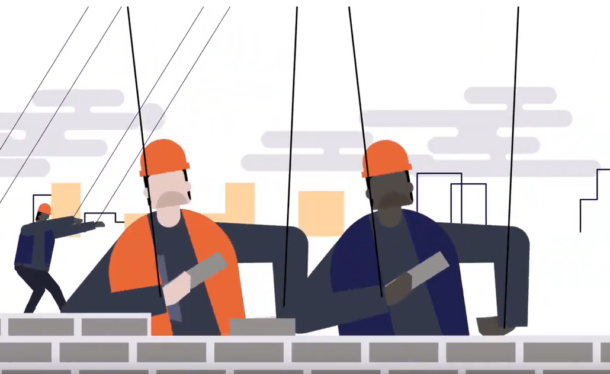With an estimated 49.6 million victims of modern slavery worldwide and an estimated 122,000 victims in the UK, countries are moving to make businesses more accountable for abuses in their supply chains. Governments around the world are insisting on anti-slavery transparency disclosures with a steady increase in criminal and civil enforcement actions being taken. No longer can businesses relinquish their responsibilities by turning a blind eye to what’s happening in the supply chain.
The built environment is considered high risk for modern slavery and wider exploitation due to the huge demand for labour, a severe skills shortage, complex supply chains and the prevalence of indirect and self-employment. The Unseen Modern Slavery helpline has reported a 35% increase in calls related to the construction sector. Operation Cardinas unravelled how an organised crime group placed more than 500 victims of modern slavery onto major construction sites in the South East between 2008 – 2019.
Consider your global supply chains – according to the Global Slavery Index 2023, at risks goods imported by the G20 are worth US$468 billion. Some of the big high-risk categories include electronics (US$243.6 billion), garments (US$147.9 billion) and solar panels (US$14.8 billion).
- Do you understand your responsibilities under the Modern Slavery Act 2015?
- Do you understand the potential implications of the growing wave of global due diligence legislation on your own supply chains?
- Do your employees and supply chain know how to spot the signs of modern slavery?
- What can you do to set up your sites to combat modern slavery?
- What due diligence can you demonstrate?
- Do you understand where the risks lie in your supply chain?
- How do you embed best practice in combatting modern slavery in your procurement processes and contract management?
A practical guide to
Addressing modern slavery and labour exploitation in the built environment
These resources will support your due diligence approach by helping you to prevent, identify, manage, mitigate and remediate modern slavery and labour exploitation risks, across your operations and supply chains.
These headings align with the key themes outlined in BS 25700 – Organisational Responses Modern Slavery.
Explore more themes
1. Policy
Select a resource below
2. Governance
Select a resource below
3. Risk Identification & Assessment
Select a resource below
4. Awareness/Competency/Training/Comms
Select a resource below
5. Grievance Mechanisms
Select a resource below
6. Procurement and Supply Chain Management
Select a resource below
7. Recording/Reporting/Measurement
Select a resource below
8. Recruitment & Employment
Select a resource below
9. Remediation
Select a resource below












Procurement Guidance: Addressing Modern Slavery in Solar PV Supply Chains

Download this free procurement guide written by Action Sustainability. The guide looks at the modern slavery risks and impacts in the PV supply chain, then outlines critical steps to address these issues throughout the commercial lifecycle (taking into account leverage). It offers insights into effective solar PV procurement due diligence, with practical tips and guidance for implementation.
With an estimated $14.8 billion of solar panels imported by G20 countries at risk of containing modern slavery, everyone who influences the procurement of solar PV has a role to play.
If you use the guide, you can’t claim assurance of zero forced labour in your supply chain, but you can say you’re aligned with procurement best practice for solar PV.
NOTE: This guide focuses on solar PV; however, the content is transferable and could be used to support responsible sourcing strategies for other renewable energy technology.
Modern Slavery - Sustainability Short
Can you spot the signs? A film designed to support your employees in understanding the signs of modern slavery in today’s working environment. The film explains how any individual on site can help identify victims of this crime and provides details of where to go to get help.
Modern Slavery
Beyond the Shadows – Unseen
Video
Modern Slavery
Operational Toolkit: Combatting Slavery in the Built Environment (Accessible Version)
Document/Presentation
Modern Slavery
BS 25700: Organizational responses to modern slavery
Web link
Modern Slavery
Transparency in supply chains: A practical guide 2025
Document/Presentation
Modern Slavery: Beyond Compensation Virtual Conference Recording
Modern Slavery
Survivor insights – ten years on from the Modern Slavery Act
Video
Modern Slavery
A Practical Guide to Understanding Modern Slavery Risk in Supply Chains
Sustainable Procurement
List of goods produced by child labour or forced labour
Document/Presentation
Supply Chain Management
Supply Chain Mapping and Modern Slavery
E-learning module
Supply Chain Management
Supply Chain Mapping Protocol
Document/Presentation
Sustainable Procurement
Supply chain mapping results
Document/Presentation

Right to Work Guidance
The purpose of this guidance is to assist Supply Chain Sustainability School members who are employers and recruiters, or those responsible for recruitment and employment to:
- Understand Right to Work
- Get to grips with the implications of GDPR in Right to Work checks
- Have easy access to the Home Office guidance checklists and toolkits available to help with Right to Work checks
- Recognise the interconnectivity between all the people challenges faced in the built environment
- Gain practical insights from School Partners in relation to Right to Work checks
- Learn about some of the digital tools available to help with Right to Work checks
- Identify where non-compliance is occurring and understand how to address it
- Understand how you could engage with your supply chain around Right to Work and what best practice looks like.
Modern Slavery
Modern Slavery Statement Registry
Web link
Modern Slavery
The UK Government Modern Slavery Statement
Web link
Modern Slavery
Modern Slavery Assessment Tool
Web link




 15 minutes
15 minutes